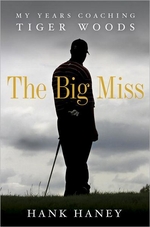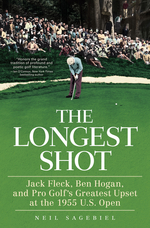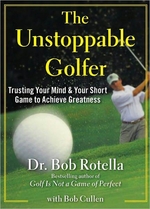Summer Golf Reading for 2012
Golf Books
Summer Golf Reading for 2012

Halfway through the 2012 professional golf season, the year may well be designated as Tiger Woods 2.0. For the first decade of the 21st century, Tiger dominated golf in a manner unlike any professional golfer in history. He won 12 major championships and was PGA Player of the Year eight times. These accomplishments occurred despite his limited play during his 2008 and 2009 seasons while recovering from a knee injury. Late in 2009, Tiger suffered a far greater injury than his knee, an injury to his reputation after news of marital infidelity and sexual escapades surfaced. Tiger, the All-American man, was kaput.
Tiger fought back, but not without struggle. While he worked to return to major championship form and even to competitive golf on the regular PGA Tour, it was a long battle. In his absence, many young and skilled golfers began winning majors. As 2012 began, many wondered if the 36-year-old would ever again win a major championship or even be competitive on the tour.
Tiger has partially answered that question with three tour victories through the end of June. But in this year’s first two major championships, the Masters and the U.S. Open, he has failed to add to his total of 14 major victories.
 The story of Tiger Woods’ comeback is clearly not yet complete, but it has been partially chronicled in THE BIG MISS: My Years Coaching Tiger Woods by Hank Haney. Woods and Haney are two of golf’s biggest names. The combination of their popularity and Haney’s account of attempting to bring Tiger back to golfing prominence vaulted the book to the New York Times bestseller list. This is a good start to a spate of outstanding golf books that always reach bookstores this time of year as major championships are contested and the majority of America’s golfers return to courses in the spring.
The story of Tiger Woods’ comeback is clearly not yet complete, but it has been partially chronicled in THE BIG MISS: My Years Coaching Tiger Woods by Hank Haney. Woods and Haney are two of golf’s biggest names. The combination of their popularity and Haney’s account of attempting to bring Tiger back to golfing prominence vaulted the book to the New York Times bestseller list. This is a good start to a spate of outstanding golf books that always reach bookstores this time of year as major championships are contested and the majority of America’s golfers return to courses in the spring.
THE BIG MISS is one part biographical and two parts tell-all. Readers will learn about Haney, who is famed for his attempts to improve the golf game of several celebrities on The Golf Channel. Haney is not reluctant to acknowledge many of his personal shortcomings. His golf game is not nearly as good as most would expect, and there have been times when he was reluctant to play with his professional students. He also admits to his alcoholic issues, and one might ponder how his work with Tiger severely tested his recovery.
If you are a Tiger fan, Haney’s account of their six-year working relationship may not be the book you want to read. Tiger, to put it mildly, was cheap. While Haney was paid what many would consider a substantial salary, the relationship required 100 days a year on the road and 24-hour telephone availability. On an hourly basis, it was not the salary that a man of Haney’s stature could have earned elsewhere. One might think that a swing coach and golfer would have a complete and open relationship because the game of golf is as much mental as physical. But Haney makes it clear that Tiger was not a sharing person. “There were never any substantive life conversations between us,” Haney informs readers.
There is no doubt that Tiger is an incredibly hard worker whose love for golf cannot be denied. Readers will understand what it takes to be a winner on the tour, despite Haney’s technical discussions detracting from the book's overall quality. Ultimately, your view of the book will hinge on how you view Tiger Woods. Either way, THE BIG MISS is a good read for those interested in how the professionals approach instruction and practice.
Tiger Woods' first tour victory in nearly three years occurred in March at the Arnold Palmer Invitational at Bay Hill. The respect and gratitude that most golfers feel for Palmer is reflected in the fact that very few of the present stars of the PGA Tour decline to attend Palmer’s event. Professional golfers, including Tiger, freely admit that Palmer is the father of modern professional golf, large purses and lucrative television contracts. Palmer is now 83 years old, and despite retirement from active tournament golf for many years, he remains one of the sport's top money earners.
THE CLASSIC PALMER by John Feinstein, with photographs by Walter Iooss, is a beautiful coffee table book for a very small coffee table. Measuring only 5 ½ by 7 ½ inches, it's a collection of beautiful Palmer photographs taken during his seven decades of professional golf and coupled with compelling narrative by John Feinstein, an author whose contributions to the golfing world are unchallenged.
book for a very small coffee table. Measuring only 5 ½ by 7 ½ inches, it's a collection of beautiful Palmer photographs taken during his seven decades of professional golf and coupled with compelling narrative by John Feinstein, an author whose contributions to the golfing world are unchallenged.
This is not a biography; Feinstein has written an essay that recounts the contributions of Palmer to professional golf. Many are too young to remember that in the 1960s, professional golf was a blip on the entertainment radar. Palmer changed all of that. He caused many to spend their weekend afternoons in front of television sets as he often charged from behind with gambling shots to snatch victory. It was Palmer who created the notion of the professional grand slam of golf: the Masters, U.S. Open, British Open and PGA. Indeed, it was Palmer who single-handedly revived the British Open when most American professionals would not travel overseas to the event.
THE CLASSIC PALMER is a wonderful book for those of my generation who recall Palmer with joy (I still fondly remember asking for and receiving his autograph at the Western Open in Chicago in 1966). Younger golfers, who believe that golf began with Tiger Woods, likewise will appreciate this beautifully written and photographed piece of golfing history.
Last month, the U.S. Open returned to the Olympic Club in San Francisco for its fifth Men’s Championship. No visit to that venue can fail to evoke memories of one of the greatest tournaments and upsets in Open history. In 1955, Ben Hogan was recognized as the most outstanding professional golfer in the world. He appeared to have won his record fifth U.S. Open on Saturday, June 18th. NBC, televising the event for only the second year, went off the air declaring Hogan the victor. However, there were still golfers on the course when the broadcast concluded. In those years, the U.S. Open ended with 36 holes of golf on Saturday. Golfers were not grouped by score, so Hogan had finished earlier than many other competitors. Jack Fleck, a driving range professional from Iowa, birdied two of the final holes to force an 18-hole playoff with Hogan on Sunday.
 Marking the return to Olympic and one of golf’s greatest upsets, two authors have recounted the events of the Hogan-Fleck confrontation. THE UPSET: Jack Fleck's Incredible Victory Over Ben Hogan at the U.S. Open is a narration by long-time golf writer Al Barkow, whose 50-year career has seen him write more than a dozen golf books. THE LONGEST SHOT: Jack Fleck, Ben Hogan, and Pro Golf's Greatest Upset at the 1955 U.S. Open is by Neil Sagebiel, the founder and editor of Armchair Golf Blog.
Marking the return to Olympic and one of golf’s greatest upsets, two authors have recounted the events of the Hogan-Fleck confrontation. THE UPSET: Jack Fleck's Incredible Victory Over Ben Hogan at the U.S. Open is a narration by long-time golf writer Al Barkow, whose 50-year career has seen him write more than a dozen golf books. THE LONGEST SHOT: Jack Fleck, Ben Hogan, and Pro Golf's Greatest Upset at the 1955 U.S. Open is by Neil Sagebiel, the founder and editor of Armchair Golf Blog.
Both books cover the essential and well-known elements of the memorable Open championship. Hogan was at the top of his game after his recovery from a near-fatal automobile accident in 1949. He recovered and confined his golf to very few tournaments. In 1953, he won five of the six tournaments he entered, including the Masters, U.S. Open and British Open. He could not compete in the PGA Championship because it conflicted with the British Open. At Olympic Club, Hogan hoped to achieve his fifth U.S. Open victory and separate himself from all other Open champions.
Jack Fleck was the antithesis of Hogan. He ran a driving range in Iowa and only qualified for the Open by succeeding in grueling sectional qualifications. For the Open, Fleck purchased a new set of irons --- Ben Hogan’s signature irons manufactured by Hogan’s Texas factory.
Both THE UPSET and THE LONGEST SHOT provide a dramatic account of the end of the final round  as Hogan waited to see if anyone could match his score and the following day’s playoff. Hogan never completely recovered from the injuries of his automobile crash. Before playing, he was forced to wrap his legs and torso with bandages, and walking 18 holes of golf was a brutally tiring exercise. There can be no doubt that the extra playoff round taxed his physical abilities far more than the younger Fleck. But Hogan never complained or made any excuses, as was his nature.
as Hogan waited to see if anyone could match his score and the following day’s playoff. Hogan never completely recovered from the injuries of his automobile crash. Before playing, he was forced to wrap his legs and torso with bandages, and walking 18 holes of golf was a brutally tiring exercise. There can be no doubt that the extra playoff round taxed his physical abilities far more than the younger Fleck. But Hogan never complained or made any excuses, as was his nature.
If you are going to read only one of these two books, my recommendation is THE LONGEST SHOT. Both are fine accounts of what probably is, along with Francis Ouimet’s victory at Brookline in 1913, one of the two greatest U.S. Opens in history. Sagebeil does a better job pacing the final round and the playoff, and his writing adds drama even to a reader who knows how it ends. In addition, one area where the authors differ is Hogan’s grace in defeat, where Sagebeil makes the stronger and more compelling case.
 No season of golf titles is complete without at least one book of instruction. Dr. Bob Rotella is well-known to golfers for his work on the mental aspects of the game. What Hank Haney is to ball-striking, Rotella is to what the legendary Bobby Jones referred to as the most important six-inches of golf --- the space between the ears. Rotella has written several books on the mental aspects of the game. He has worked with an all-star list of professional golfers who since 1984 have won 74 major professional titles on the PGA, LPGA and Senior PGA Tours combined. THE UNSTOPPABLE GOLFER: Trusting Your Mind & Your Short Game to Achieve Greatness is Rotella’s latest effort, and like all of his books, there are great tips for golfers of all skill levels. Even though most of us cannot physically generate the club head speed of Tiger or Bubba Watson, we can avoid stupid mistakes on the golf course by simply playing smarter.
No season of golf titles is complete without at least one book of instruction. Dr. Bob Rotella is well-known to golfers for his work on the mental aspects of the game. What Hank Haney is to ball-striking, Rotella is to what the legendary Bobby Jones referred to as the most important six-inches of golf --- the space between the ears. Rotella has written several books on the mental aspects of the game. He has worked with an all-star list of professional golfers who since 1984 have won 74 major professional titles on the PGA, LPGA and Senior PGA Tours combined. THE UNSTOPPABLE GOLFER: Trusting Your Mind & Your Short Game to Achieve Greatness is Rotella’s latest effort, and like all of his books, there are great tips for golfers of all skill levels. Even though most of us cannot physically generate the club head speed of Tiger or Bubba Watson, we can avoid stupid mistakes on the golf course by simply playing smarter.
Rotella makes the important but obvious point that most golfers find success or failure around the green. Two-thirds of a golfer’s shots come on or around the green. However, most players do not devote much time to either practicing or understanding the nuances of putting, chipping and approaching greens. Rotella suggests that golfers have far too many swing thoughts as they get around the green. Instead of focusing on these thoughts, they should clear their mind, cleanse their thought process, and focus on one thing --- the target. While it might appear so basic as to not even need a book, Rotella builds his case. In doing so, he builds your confidence. I followed Rotella’s advice and immediately saw improvement in my short game and my handicap. It is the best endorsement for a book I can think of.
--- Reviewed by Stuart Shiffman


